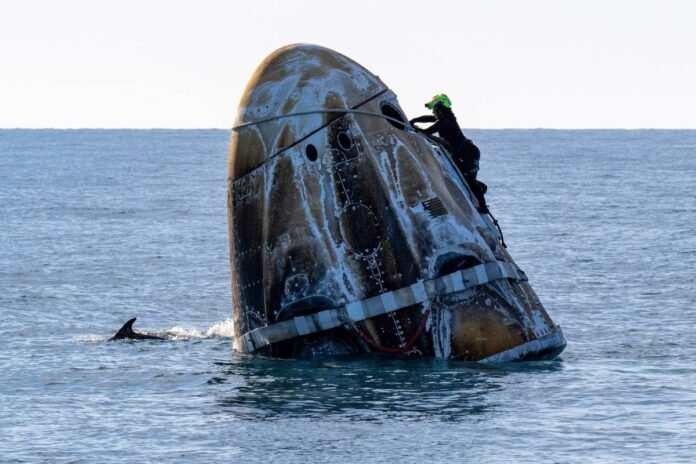NASA astronauts Butch Wilmore and Suni Williams finally returned to Earth on Tuesday after spending nine months in space.
Their unexpected extended stay ended with a ride back on a SpaceX capsule, marking the conclusion of a mission that began with a problematic test flight last year.
Their journey home began when the SpaceX capsule separated from the International Space Station and headed back to Earth. Just hours later, it splashed down in the Gulf of Mexico near Tallahassee, Florida. The successful landing signaled the conclusion of their extended space adventure.
Within an hour of splashdown, both astronauts exited the capsule, waving to cameras and smiling. They were promptly placed on reclining stretchers for routine medical checks, ensuring they had adjusted well after their extended time in microgravity. The return home was long overdue.
Originally, Wilmore and Williams were scheduled to stay in space for just one week.
However, their Boeing Starliner capsule encountered multiple issues upon reaching the International Space Station. NASA decided to send the faulty capsule back to Earth without them and instead arranged for their return aboard a SpaceX vehicle.
Complications with the SpaceX capsule further delayed their return, extending their mission into March. Finally, on Sunday, the arrival of their relief crew gave NASA the go-ahead to depart earlier than planned, avoiding potential weather complications later in the week.
Over the course of 286 days, Wilmore and Williams completed 4,576 orbits around Earth and traveled 121 million miles. Their unexpected mission extension turned them from short-term visitors into full-fledged crew members conducting scientific research and space station maintenance.
“On behalf of SpaceX, welcome home,” SpaceX Mission Control in California announced over the radio as the astronauts landed. In response, Wilmore expressed his excitement, stating, “What a ride,” while acknowledging the capsule full of grinning faces.
As divers prepared the capsule for recovery, dolphins swam around it in the Gulf. Once the astronauts were safely onboard the recovery ship, they emerged one by one, with Wilmore giving two thumbs up in celebration of their successful return.
Their extended stay in space captured public attention, with “Butch and Suni” becoming well-known names.
Though other astronauts have completed longer missions, few have faced such uncertainty about their return schedule, making their journey particularly noteworthy.
Despite the unexpected duration, Wilmore and Williams adapted quickly. They fully integrated into station operations, conducting research, repairing equipment, and even performing spacewalks. Williams set a record among female astronauts, accumulating 62 hours over nine spacewalks.
Both astronauts had previous experience aboard the space station, which helped them transition smoothly into their extended mission.
Williams took over as station commander three months into their stay and maintained the role until earlier this month when the relief crew arrived.
In January, former President Donald Trump urged SpaceX founder Elon Musk to speed up the astronauts’ return, adding political pressure to their mission.
Responding quickly, SpaceX chose a previously flown capsule rather than waiting for a new one, accelerating their journey home by several weeks.
After splashdown, Musk congratulated the astronauts on social media. NASA officials, including Joel Montalbano, explained that they had already been evaluating return options before Trump’s public comments, emphasizing that safety remained the top priority.
Throughout their time in orbit, Wilmore and Williams remained professional, avoiding political discussions.
They consistently expressed their trust in NASA’s decision-making and remained focused on their work, demonstrating resilience in the face of uncertainty.
NASA originally hired SpaceX and Boeing to provide astronaut transport services after the space shuttle program ended. These partnerships ensure the U.S. has multiple options for space travel as the agency prepares to transition to private space stations after the ISS is retired in 2030.
NASA’s commercial crew program manager, Steve Stich, praised the astronauts’ patience and adaptability. He emphasized that their mission highlights the importance of flexibility in human spaceflight and underscores the agency’s commitment to future exploration.
With Boeing’s Starliner still under engineering review, SpaceX is set to launch the next NASA crew as early as July.
NASA will determine by summer whether Boeing will be allowed to fly astronauts next or if further testing will be required before another crewed mission.
Wilmore and Williams, both retired Navy captains, compared their prolonged stay in space to military deployments. While they embraced the challenge, they acknowledged that being away from their families for so long was difficult.
Wilmore, 62, missed much of his younger daughter’s senior year of high school, while his older daughter is in college. Williams, 59, kept in touch with her husband, mother, and other relatives through internet calls but was eager to reunite with them in person.
In anticipation of their return, prayers were held in 21 Hindu temples across the U.S., recognizing Williams’ Indian heritage.
Meanwhile, Wilmore’s Baptist church in Houston also offered prayers, demonstrating broad support from their communities.
In Jhulasan, the ancestral home of Williams’ father, locals celebrated with temple dances and traditional rituals. Their joyous reaction reflected the pride felt in her achievements and the successful completion of the mission.
After landing in the Gulf, which was recently renamed the “Gulf of America” by Trump, the astronauts still had to wait before reuniting with their families. NASA flight surgeons would monitor their readjustment to gravity before they could finally return home.


